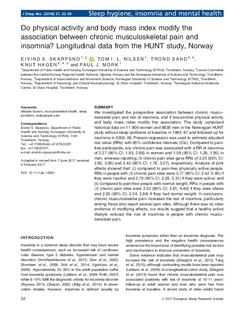Do physical activity and body mass index modify the association between chronic musculoskeletal pain and insomnia? Longitudinal data from the HUNT study, Norway.
Journal article, Peer reviewed
Published version
Permanent lenke
http://hdl.handle.net/11250/2497090Utgivelsesdato
2017Metadata
Vis full innførselSamlinger
Sammendrag
We investigated the prospective association between chronic musculoskeletal pain and risk of insomnia, and if leisure‐time physical activity and body mass index modify this association. The study comprised historical data on 11 909 women and 9938 men in the Norwegian HUNT study without sleep problems at baseline in 1995–97 and followed‐up for insomnia in 2006–08. Poisson regression was used to estimate adjusted risk ratios (RRs) with 95% confidence intervals (CIs). Compared to pain‐free participants, any chronic pain was associated with a RR of insomnia of 2.27 (95% CI: 1.93, 2.66) in women and 1.58 (95% CI: 1.28, 1.95) in men, whereas reporting ≥5 chronic pain sites gave RRs of 3.20 (95% CI: 2.60, 3.95) and 2.40 (95% CI: 1.76, 3.27), respectively. Analysis of joint effects showed that: (i) compared to pain‐free physically active people, RRs in people with ≥5 chronic pain sites were 3.77 (95% CI: 2.42–5.85) if they were inactive and 2.76 (95% CI: 2.29, 3.31) if they were active; and (ii) compared to pain‐free people with normal weight, RRs in people with ≥5 chronic pain sites were 3.52 (95% CI: 2.81, 4.40) if they were obese and 2.93 (95% CI: 2.24, 3.84) if they had normal weight. In conclusion, chronic musculoskeletal pain increases the risk of insomnia, particularly among those who report several pain sites. Although there was no clear evidence of modifying effects, our results suggest that a healthy active lifestyle reduces the risk of insomnia in people with chronic musculoskeletal pain.
